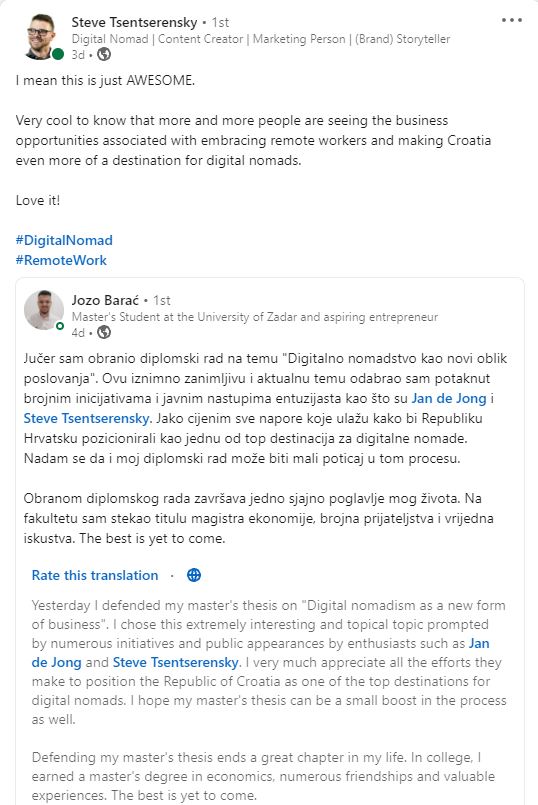Milanović and Pahor Unveil Monument to Slovenian Poet Prešern in Zagreb
ZAGREB, 18 Oct 2021 - Croatian and Slovenian Presidents, Zoran Milanović and Borut Pahor, unveiled a monument to a Slovenian poet, France Prešeren in Zagreb's Bundek Park, on Monday after they had unveiled a bust to one of the leaders of the Croatian National Revival, Ljudevit Gaj in Ljubljana earlier in the day.
The monument to Peršen is situated in Bundek Park's Alley of Poets, thus joining monuments to the Russian writers Aleksandr Pushkin and Sergei Yesenin, the Hungarian writer Mór Jókai and the father of Bulgarian literature, Ivan Minchev Vazov.
Prešern's poem Zdravljica (A Toast) is the text of the Slovenian national anthem.
Addressing the public, Milanović said that Croatian and Slovenian anthems were created during the same period and they also have in common the fact that that they are peaceful.
"What it (the Slovenian anthem) has in common with the Croatian anthem, besides being written at nearly the same time, is that it is very peaceful”, President Milanović stated at the unveiling of the bust of France Prešeren.
Milanović added that both Gaj and Prešern were "lawyers by profession, but unsuccessful ones."
"It was at the time when the national word and language, without which there is no nation, were formed, built, measured, and designed by lawyers. Today this is unthinkable. Such were the times, today we live in the time of a bureaucratized, but common European Union. A most beautiful day, this morning Gaj in Ljubljana, and this afternoon Prešeren – let us continue this way. Croatian-Slovenian relations are becoming a more and more beautiful story, and there is no reason for it not to remain as such," President Milanović said in concluding his address during the bust-unveiling ceremony at Bundek.
Pahor described Prešeren as "a key figure in Slovenian history," and that his poetry "promotes European values like good neighborly relations, coexistence and fostering differences."
He underscored that today great divisions exist in Slovenia, Europe, and the world and that in that context Zagreb and Ljubljana are capitals that are showing "Europe as their joint home" how to celebrate their own and European identities based on values that bring peace and security.
"I want this day to be a holiday of good neighborly relations, coexistence, friendship, and trust between two nations," said Pahor.
The idea for the monument to France Prešeren was initiated by Slovenia's Embassy and the Slovenian House in Zagreb whereby the Slovenian community in Croatia is celebrating 30 years of Slovenia's independence.
The City of Zagreb prepared the site for the monument and Mayor Tomislav Tomašević said today that he was happy to support the project.
"This monument is an expression of respect for and friendship with the Slovenian people," said Tomašević during the ceremony.
France Prešeren, who was born on 3 December 1800 and died on 8 February 1849, is generally acknowledged as one of the greatest Slovenian poets.
For more on politics, click here.
Božinović: COVID Vaccine Best Prevention Against Serious Illness
ZAGREB, 18 Oct 2021- The head of the national COVID-19 crisis management team, Davor Božinović, said on Monday, ahead of the start of the administration of the third vaccine dose, that vaccination was the best prevention against serious illness and hospitalization.
"We can protect ourselves from the most serious illness, individually and as a community, if we accept the fact that science, not just in this epidemic but in previous ones too, has helped humankind to survive," he told the press in Našice.
He added that "those who don't trust science first of all harm themselves, and then the community."
He said the recent rise in new cases meant a rise in hospitalizations and that vaccination was the proper defense against that.
For all you need to know about coronavirus specific to Croatia, make sure to bookmark our dedicated COVID-19 section and select your preferred language.
For more on politics, CLICK HERE.
Digital Nomads Zagreb Meetup with October Ambassador, South African Andrae Smith
October 18, 2021 - The community is growing, and the invitations are open to the next Digital Nomads Zagreb Meetup this Thursday, with special guest Andrae Smith, the Zagreb Digital Nomad Ambassador for October.
Zagreb is on the move.
More and more digital nomads are discovering the city, and they are liking what they see. And as TCN reported earlier, progress has been made on multiple fronts (Zagreb for Digital Nomads: A Destination on the Rise).
At the core of any potential success will be a healthy and interactive community. It is still early days, but things are looking very healthy in that regard. The main Facebook group, Digital Nomads Croatia, now boasts over 7,500 members, and their regular meetups are always popular.
Last month, the Digital Nomads Croatia Facebook group teamed up with the Zagreb Digital Nomad Ambassador (a collaboration between Zagreb Tourist Board, Saltwater Nomads, Doma Zagreb Aparthotel, and TCN), as September ambassador Dean Kuchel from Israel held first an AMA (Ask Me Anything) evening at Bustan, followed by a farewell Zagreb Pitch night at Canopy by Hilton.
The incoming October ambassador, Andrae Smith was at the Canopy event, having literally just flown in from South Africa. Andrae is now just over halfway through her time in Zagreb, and she will be the special guest at the next Digital Nomads Zagreb meetup this Thursday, at Bustan Bar on Varsavska from 19:00.
Andrae will be giving a presentation about her online business and remote work lifestyle, as well as hosting an AMA session and talking about the most common questions she encounters.
You can meet Andrae in her video application for the ambassador project above.
Link to the event on Facebook, which is open to all.
To read more news and features on digital nomads in Croatia, follow the dedicated TCN section.
Uber Drivers Strike in Croatia: ''We Feel Like Digital Slaves''
October 18, 2021 - As part of the Uber drivers strike in Croatia, a press conference was held. They claim: ‘‘We cannot get in touch with the company. We have not received an explanation as to why the money is late and when it will be paid. (...) We feel like digital slaves’’.
This morning, Uber drivers went on strike in Zagreb and its surroundings because their salaries were late, reports Telegram.hr. The salary that was supposed to sit last Tuesday was paid this morning, and Uber claimed over the weekend that the delay was due to an error in the local bank system. Nevertheless, the Uber team continued with the strike organized by the Croatian Digital Platform Workers' Union until 10 am this morning. At 10 am, the secretary of the Trade Union, Iva Filipović, addressed the media.
Filipovic said that they decided to promote an Uber driver strike because they estimated that an immediate response was needed. They appealed to Uber to show solidarity with them. "We are sorry that the application had to be blocked, but we are in such a relationship that we feel like digital slaves," she said in front of Uber's headquarters in Croatia.
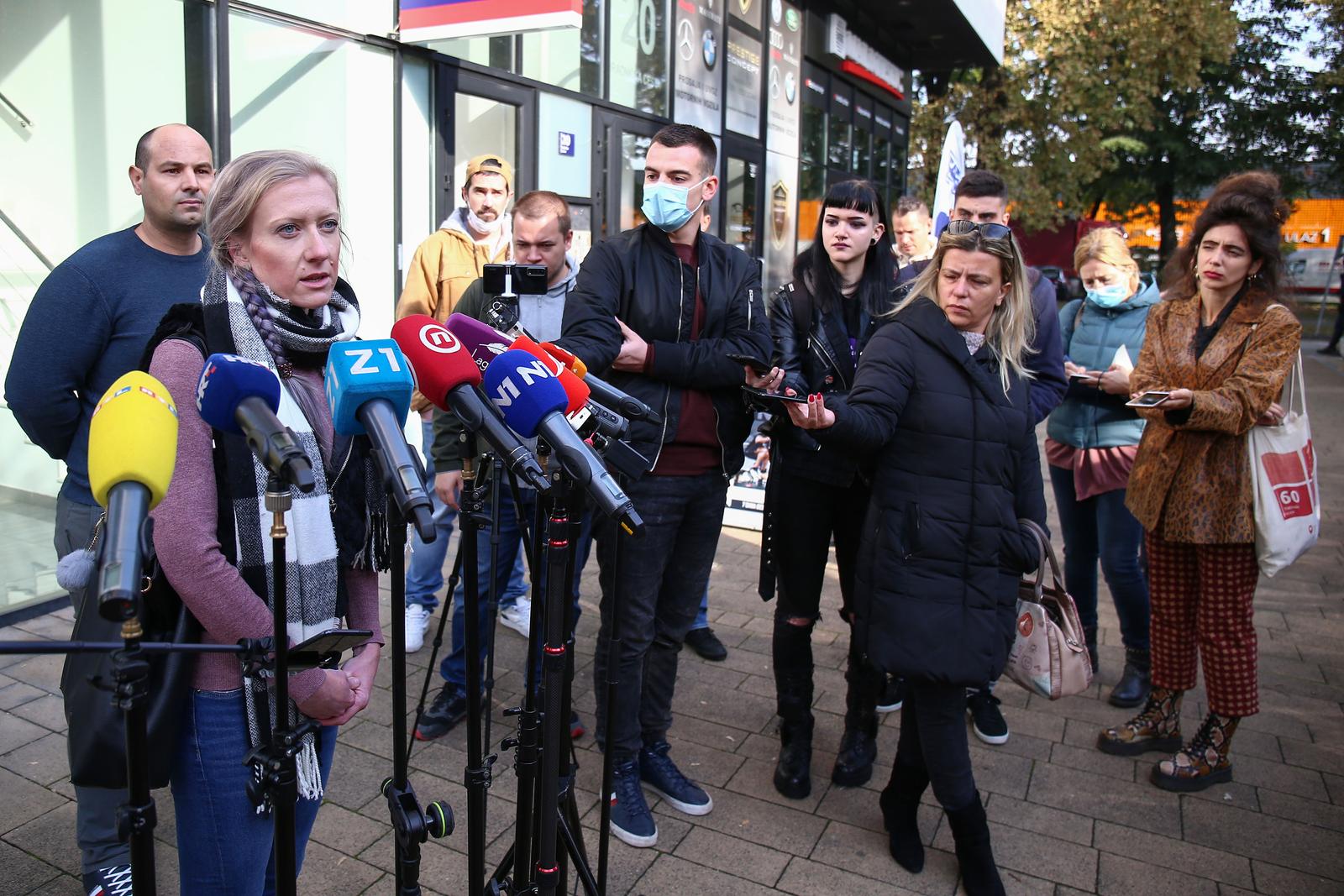
Iva Filipović addressed the media this morning during the Uber drivers strike in Zagreb. (Photo: Photo: Matija Habljak/PIXSELL)
She added that Uber constantly emphasizes that their drivers are partners, that they are socially aware and care about the community. “Then how can we not get in touch with them? We have not received an explanation of what is happening, why the money is late and when it will be paid," she said, adding that the money was paid today.
‘‘We can’t talk to any natural person’’
She said they continued the boycott until 10 a.m. to send a message to Uber. “Unfortunately, we can’t talk to any natural person from Uber,” she said, adding that this can happen with any other digital platform, not just Uber. She also said that drivers in Zagreb can, at best, meet with a student who can solve some basic problems in the application. "Drivers from the rest of Croatia can only get an appointment online," she added.
“I’m sorry because no one from Uber showed up, we were hoping someone from the authorities would come out and explain to us what was going on,” she said, saying that says enough about Uber’s claim that their drivers are actually partners. When asked by reporters, she said that the boycott was felt and that users waited twice as long for the ride as well as that the rides were twice as expensive. "It's hard to say, but experience shows that a large number of drivers who would otherwise be on the road were not there today," she said.
Journalists at the Uber drivers strike also asked her how many drivers Uber has in Croatia, to which she replied that only Uber can answer. She also said that they are a new union whose membership is growing, although they are aware that people in Croatia are afraid of union association. She added, however, that some problems like this with salaries can only be solved if they work together.
‘‘If Uber doesn’t pay me, I can’t pay the benefits’’
She also explained that the problem is that she is, for example, as far as the state is concerned, a self-employed person to whom Uber is a partner. “If Uber doesn’t pay me, I can’t pay the benefits to the state I owe,” she said. She said it was important to regulate the area to get workers ’rights.
She also told reporters that they want to solve the problem with Uber through dialogue, adding that roadblocks are not an option as part of the Uber drivers strike. She assures that they do not want to make it difficult for citizens to move. In the end, she added that tomorrow is the day for the payment of funds and that she hopes that there will be no delays.
For more, check out our business section.
Changing the Mindset: Digital Nomadism in Croatia, an Academic Thesis
October 18, 2021 - Changing the mindset of the next generation is one of the key benefits for Croatia with the digital nomad opportunity - a topic which is now the subject of an academic thesis.
One of my favourite moments at the excellent Dubrovnik Digital Nomads-in-Residence programme back in April was having a coffee with one of the local attendees on the first day of the design thinking workshop which helped create the strategy and roadmap forward for Dubrovnik's digital nomad journey.
"This has been mindblowing," she said. "A completely new way of living, and of thinking. And I have already decided that I am going to trade in my current way of life for the digital nomad revolution."
The world of work is changing, and the era of remote work is here. I have been thoroughly enjoying meeting lots of progressive people over the last year, many of whom are foreigners who have chosen to combine their online job with the enviable Croatian lifestyle - a winning combination. And the more people who come with this new way of working, with their fresh ideas, the more they will inspire a new way of thinking in the younger generation in Croatia, many of whom choose emigration over trying to make a life here.
And if seems that interest is trickling down to the world of academia.
This LinkedIn post from digital permit holder, Steve Tsentserensky, made me smile. Steve has been doing sterling work promoting Croatia, from speaking at conferences and writing viral articles for CNBC on the subject, to producing outstanding photos and videos as he explores the country. Great to see that both he and Jan are a cause for inspiration.
I decided to reach out to Jozo Barac about his choice of thesis, thinking it must be the first thesis in Croatia on the subject. It apparently was the second, as he informed me:
Through a detailed search, I found that so far only one Master thesis in 2020 has been written on the topic of digital nomadism in Croatia. In my opinion, this paper was written as a fairly general account of digital nomadism. Therefore, I wanted to write a thesis that will clearly show what digital nomadism is, what are the most common occupations, what is needed to develop a destination for digital nomads and how Croatia is positioned in the context of such a destination. Also, I conducted research on young people of different study orientations. In this research, I measured their attitudes and motivation and, through three different hypotheses, statistically tested whether there were significant differences in their attitudes and motivation for digital nomadism.
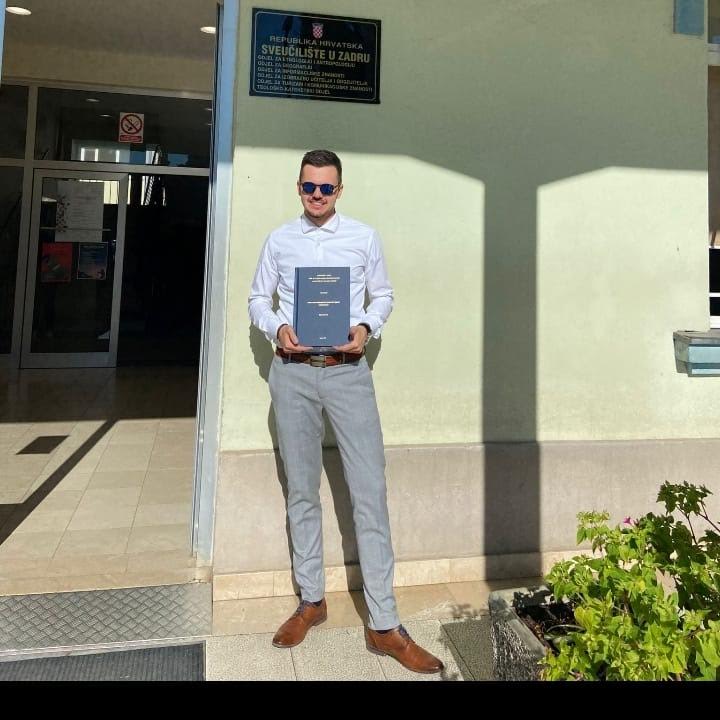
Inspired by the likes of Steve and Jan, Jozo dived into his research into this new world of opportunity. He told me:
I believe that Croatia meets three basic prerequisites for the development of such destinations, namely fast and stable Internet, climate conditions and acceptable living costs. Also, we are a safe destination and have many cultural and natural attractions. Our highways are good, while the railways are very bad. I believe that by increasing the number of digital nomads in Croatia, new airlines will be introduced. Furthermore, within this destination development, numerous entrepreneurial opportunities can be realized. Some of these opportunities are the opening of coworking and coliving spaces and the creation of various gastronomic and adrenaline tours for digital nomads. I absolutely support the recent opening of the valley for digital nomads in Zadar and I believe that there will be more and more such projects.
Congratulations to Jozo on his graduation, and good luck on your entrepreneurial journey. You can find a summary of Jozo's thesis below, and you can connect with him on LinkedIn if you want to know more.
Digital nomadism as a new form of business
Travel has been an indispensable part of human life since the beginning of the development of all civilizations. The main motives for the trip were usually a change of environment, rest, recreation, meeting new cultures and people. Today, people most often travel during the holidays which they use to rest and recover from stressful everyday life. However, for many, traveling in these quantities is not enough and they are looking for ways to travel more.
One way to travel more is definitely digital nomadism. It is a term that encompasses traveling and getting to know different cultures around the world while simultaneously earning a living with the inevitable mediation of technology and internet connection. In this paper, the introduction highlights the goals, content and methodology of the research. Also, the problem and the subject of research are defined.
The second chapter defines the concept of digital nomadism and the holistic approach to the study of this concept. Such an approach encompasses the frameworks of digital nomadism as an economic activity or model, as a cultural phenomenon and as a technologically enabled form of work. It presents the basic characteristics, positive and negative sides and the most common occupations practiced by digital nomads. Some of these professions are social media marketing expert, SEO expert and e-retailer of digital products. Also, the basic legislative frameworks around the world concerning the topic of this paper are presented. The Republic of Croatia should be highlighted as a country that has clearly defined the conditions of stay of digital nomads on its territory by voting on the Foreigners Act, which has been valid since 1.1.2021.
The third chapter presents the conditions for the development of destinations for digital nomads. The basic preconditions for the development of such destinations are fast and stable internet connection, climatic conditions and low cost of living. In this chapter, the Republic of Croatia is placed in the global context of such destinations and can be positioned as one of the most desirable destinations for digital nomads. Also, the basic possibilities and limitations of the development of such destinations are listed. In the fourth chapter, the research methodology is presented and a survey of 120 respondents was conducted through an online questionnaire. Of the three hypotheses set, the first and third hypotheses were accepted, while the second hypothesis was rejected. Based on the entire paper, basic conclusions were reached on the overall topic of digital nomadism, destination development in this context, and a number of research conclusions and recommendations for future research.
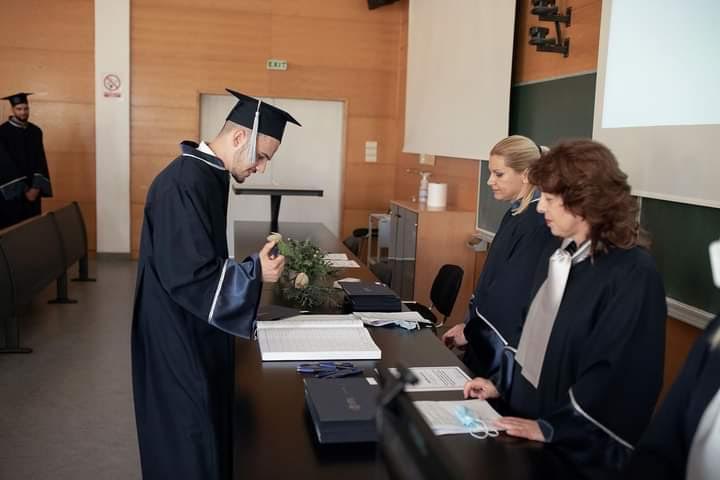
For more news and features on digital nomads in Croatia, follow the dedicated TCN section.
Croatia Reports 319 New Coronavirus Cases, 11 Deaths
ZAGREB, 18 Oct 2021 - In the past 24 hours, 319 coronavirus cases and 11 related deaths have been registered in Croatia, the national COVID-19 crisis management team said on Monday.
There are 9,299 active cases, including 945 hospitalized patients, 119 of whom are on ventilators, while 18,660 persons are self-isolating.
Croatia has registered 428,233 coronavirus cases to date, including 8,907 deaths and 410,027 recoveries. 1,293 people have recovered in the past 24 hours.
To date, 2,974,167 persons have been tested for the virus, including 2,815 in the past 24 hours, and 46.09% of the population has been vaccinated against COVID, including 55.25% of adults, of whom 51.93% have been fully vaccinated.
For all you need to know about coronavirus specific to Croatia, make sure to bookmark our dedicated COVID-19 section and select your preferred language.
Aquatika Freshwater Aquarium in Karlovac Celebrates Five Year Anniversary
October 18, 2021 - Located on the banks of the Korana river in Karlovac, the Aquatika Freshwater Aquarium seeks to educate about the rich flora and fauna of the river, as well as the environment preservation. This weekend they will celebrate five years of existence with a varied program of fun and educational activities.
As Turitičke Priče reports, the Aquatika Freshwater Aquarium, located on the banks of the river Korana in Karlovac, dedicates five years of its existence to the importance of preserving the environment. The central part of the celebration will last from October 22 to 24. Walking through the River of the Future, visitors will have the opportunity to learn more about the history of Aquatika and the topics of sustainable development through various programs. Educational programs will try to draw attention to the environment and the preservation of freshwater ecosystems, and various lectures, plays, animations, holograms, quiz and programs for children and the whole family have been selected.
In anticipation of the birthday celebration, Aquatika Freshwater Aquarium Karlovac will offer visitors a pre-program "Aquatika in the city" at several locations throughout the city of Karlovac. The Katzler Pavilion has turned its exhibition space into a large aquarium. The themes of the exhibition include the Karlovac rivers and their fish stock, and they will be on view until 31 October. The Karlovac City Museum will be able to visit the ichthyological collection as part of the "Aquatics in the Museum" program.

Aquatika in the City Library Ivan Goran Kovačić will mark the presentation shelves with books about fish and workshops for children, and the play for children "On the trail" will play for free in the theater as part of the Aquatika program in the City Theater Zorin dom on October 24.
On October 22, entry to Aquatika is free
The main part of the program will last from October 22 to 24 at Aquatika Freshwater Aquarium Karlovac. It will consist of a program on the aquarium square and a program on the River of the Future (promenades along the Korana). Visitors will be able to see the aquarium at promotional prices, see several plays, attend various educational lectures and workshops, participate in educational and quiz walks along the Korana, listen to stories, animations, and programs for children and experience the holograms of Aquatika Freshwater Aquarium Karlovac.
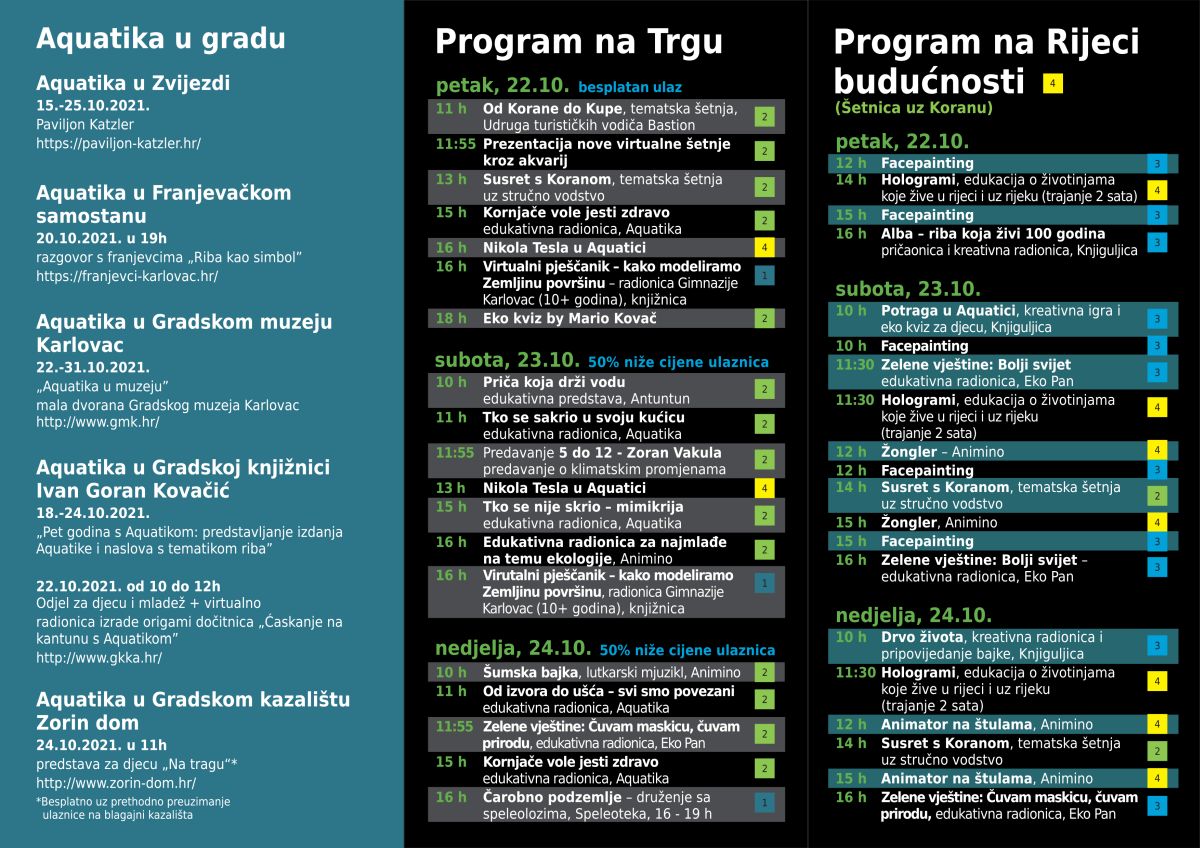
Zoran Vakula's lecture "5 to 12" should definitely be singled out, which will introduce visitors to climate change. Aquatika invites all citizens to get acquainted with the river world, and the first 500 visitors on October 22 are expecting a special gift.
It is important to emphasize that on October 22, entry to the Aquatika Freshwater Aquarium will be free, and on October 23 and 24, tickets will be available at 50% lower prices.
Aquatika has hosted more than 320,000 visitors in five years
Public institution Aquatika Freshwater Aquarium Karlovac was established five years ago as a result of a project co-financed by the European Union. Already in the first year of its existence, it has largely fulfilled the goals set in the project itself. So far, the aquarium has been visited by more than 320,000 visitors, mostly families with children, school groups, groups of retirees, hobbyists, nature lovers, and students and scientists.

The aquarium is an ecological, educational, tourist, and scientific attraction. It exudes originality considering that it is about almost all Croatian freshwater fish species, in a city on four rivers in the heart of Croatia. Through his work, in addition to the function of the aquarium, he has the task to present the traditional culture, geological past, and way of life along the rivers and collaborates on various projects with the scientific sector.
For more information about the event and other upcoming activities, as well as learning more about Aquatika Freshwater Aquarium in Karlovac, be sure to check their official Facebook page.
A beautiful city of beer, four rivers, promenades, parks and 10, 000 trees. For more about Karlovac, be sure to check Total Croatia's complete guide, Karlovac in a Page, here. Now in your language!
For more, make sure to check out our dedicated lifestyle section.
Mislav Herman Re-Elected Leader of HDZ's Zagreb Branch
ZAGREB, 18 Oct 2021 - The incumbent president of the Zagreb branch of the Croatian Democratic Union (HDZ) party, Mislav Herman, was re-elected to this post at the party's internal elections on Sunday.
Herman won 3,341 votes, while his rival Pavo Kostopeč received 1,931.
Herman called on the members of the HDZ's Zagreb branch to show unity and commitment so that they would take the helm of the city administration at the next local election.
Members of his campaign team, the current cabinet ministers Nikolina Brnjac and Josip Aladrović, as well as Mario Župan and Frane Barbarić, were elected vice-presidents.
On Sunday, the HDZ held elections for presidents and vice-presidents of 428 local and 20 regional branches, and for presidents and vice-presidents of 17 city districts, and the leadership of the party's branch in Zagreb.
For more on politics, CLICK HERE.
Vujčić: No Room for Panic About Possible Rise in Interest Rates
ZAGREB, 18 Oct 2021 – Croatian National Bank (HNB) Governor Boris Vujčić said on Sunday that Croatian citizens should not fear a sudden rise in loan installments as a result of the rise in the inflation rate.
Speaking in an interview with the HRT public broadcaster on Sunday evening, Vujčić said there was no room for panic that interest rates would rise abruptly, and with the loan payments, for citizens who have long-term loans with variable interest rates.
He noted that the interest rates had been at record low levels since 2015 and that throughout that time the HNB was warning that at one point they would get back to normal and start increasing.
He said that this approach and the HNB's recommendation to the banks to offer fixed interest rates to citizens had led to the share of the variable interest rate in loans decreasing from 90 to the present 38 percent. He added that the majority of citizens have a fixed interest rate for the first five to ten years of loan repayment, after which the interest rate becomes variable.
"This means that in normal scenarios no one will feel any significant rise in interest rates in the short term," Vujčić said.
Should the inflation rate remain high for a longer period of time, interest rates might grow at a greater speed, he said, illustrating this with an example: "If your loan matures in 20 years or more, then a one percentage point rise in the interest rate might increase your loan installment by approximately 9.5 percent, provided you have no protection such as a fixed interest rate."
Vujčić said it was not possible to make a general recommendation to citizens with long-term loans and variable interest rates to apply for a switch to loans with fixed interest rates. He, however, recalled that in 2017 the HNB had recommended to the banks to make this possible for those who make such a request.
The HNB governor said he did not expect the rise in energy prices to have the same inflationary impact it had this year.
"Energy contributed to half of the total rise in prices, which is absolutely the greatest contribution to inflation. Looking at the markets, next year energy prices are expected to stabilize or even start falling slightly," he said.
He, however, warned there was still considerable uncertainty because if prices continued to rise, that would definitely put additional pressure on inflation.
"However, we cannot expect, in any reasonable scenario, the rise that we had this year when prices rebounded from the very low levels in the pandemic year 2020 to normal levels. I do not expect anything similar to the inflationary pressure we saw this year, but energy prices are definitely important for the overall inflation trend," Vujčić said.
The HNB expects inflation to pick up to 2.3 percent this year before slowing to 2.1 percent in 2022.
For more about politics in Croatia, follow TCN's dedicated page.
Can Peljesac Bridge Withstand Bura, Earthquakes, Maritime Incidents?
October the 18th, 2021 - With the construction of Peljesac bridge finally drawing to a close and with access roads being hurried along, questions about Croatia's most important strategic project which has united its territory have arisen. Can the bridge cope with strong bura or will it need to be closed? What if an earthquake strikes or if a large vessel runs into one of its pillars? An expert provided answers.
As Morski writes, Peljesac bridge with its elegant 2404 metres has surrounded Mali Ston Bay and finally connected Croatian territory. It blends harmoniously into the Dalmatian landscape, but also into a landscape that is not completely safe, either. The bridge is located in an area known for its very frequent seismic activity, where bura and other coastal winds are common and strong. Might a stronger earthquake bring it down, how many gusts of jugo or bura can it withstand, what if a ship crashes into it, and how will its load-bearing capacity and stability be monitored over the years to come?
The answers to these pressing questions came from Croatian roads/Hrvatske ceste, that is, directly from Goran Legac, the engineer who is leading the historic project of the road connection of southern Dalmatia with the rest of the country, as reported by tportal.
His job is to prepare the project, organise, control and supervise all of the participants and their activities and ensure that everything being done is in line with the set plans in terms of deadlines and finances. Simply put, he and his team of experts from various professions, along with the help of numerous surveillance services, are the ones ''hanging'' over the heads of the Chinese workers who are building Peljesac Bridge, the Greeks (Avax) and the Austrians (Strabag) whose task is to build all of the accompanying access roads.
''For the quality delivery of the construction work itself, the most important thing is announcing and controlling all of the technical specifications through project documentation that must be completed by the contractor. Conditionally speaking, we perform the project with the same goal, but often with a different approach. The contractor strives to optimise the project in order to earn as much as possible while achieving the required quality. The designer, on the other hand, deals with all the highest standards and norms in order to make the construction as durable as possible. And that's in the interest of the client, in this case Hrvatske ceste, because of the maintenance costs involved,'' explained Legac.
In the case of Peljesac bridge, maintenance costs will be of course by very high. In theory, these costs are calculated by dividing the value of the structure by the expected period of use.
''It's common to expect that in the projected life of a construction, let's say we're talking about a 100-or-so-year period, the construction and equipment of the bridge through regular and extraordinary maintenance will be completely repaired and then replaced. So if the construction cost two billion kuna, then at least that much more will be spent in 100 years on maintenance alone. Of course, these costs will be lower in the beginning, and will increase later in accordance with the contractor's guarantees,'' stated Legac.
What exactly has been done to make sure Peljesac bridge will withstand those 100 years, and hopefully much longer, without shortening its ''shelf life'' due to some of the natural disasters such as earthquakes or strong winds Croatia is no stranger to?
Several tectonic faultlines are located very close to the bridge...
Southern Croatia is one of the most seismic areas in the entire country. According to seismologists, the maximum intensity of earthquakes that can hit Dalmatia ranges from 6.3 to 7 degrees on the Richter scale. The fact that there are several faultlines very near to Peljesac bridge isn't particularly encouraging in this case, which is evident by looking at the scientific database of all European seismic faults.
Legac confirmed all this, but also pointed out that there is no room for fear.
''It's true that the bridge is located in a zone which has very high levels of seismic activity, with a design ground acceleration at the foundation level of 0.34 g, which is extremely strong. However, the structure is designed and constructed to withstand what earthquakes can cause without collapsing. The level of usability ensures sufficient rigidity so that the bridge can be used even after an earthquake strikes. So, Peljesac bridge can withstand even the strongest earthquakes that can be reasonably expected to strike the area,'' assured Legac.
He added huge steel pipes with a diameters of 1.8 metres and two metres, were used to base the pillars in the sea itself. Their length ranges from 36 to 130.9 metres. For comparison, the height of the Zagreb Cathedral is 108 metres. These pipes were driven down firmly into the seabed, with the 130.9-metre one being the world record holder because it is the largest ever to be driven down into one piece, as pipes of these lengths are usually put in in extensions.
In addition to being located in a highly seismic area, the location of Peljesac bridge is known for some extremely strong Dalmatian winds. Will we have the same situation as we unfortunately did with the Maslenica bridge, which closes to traffic when bura or jugo blows?
Legac assured that this will not be the case. Namely, during the design and construction, the problem of local winds was taken into account and the construction of the bridge was tested in an air tunnel, writes tportal.
''The analysis predicts wind gusts of as much as 180 kilometres per hour. From my experience, because I've lived near the bridge for about three and a half years now, in Mali Ston Bay the jugo is much more intense than the bura wind is. Along the entire length of the bridge on both sides there will be windbreaks 3.2 which are metres high. You can see similar windbreaks on the Baricevic viaduct on the highway near Sv. Rok. They are a guarantee that the traffic will run smoothly in almost all weather conditions up to a wind speed of 180 kilometres per hour,'' Legac pointed out, adding that there are windbreaks on the construction site and they are waiting for installation as well.
The pillars of Peljesac bridge can withstand the impact of a ship of 10 thousand tonnes.
In addition to natural issues such as earthquakes and wind, the design of the bridge had to take into account its navigation profile, which was insisted on by neighbouring Bosnia and Herzegovina, and some Bosnian politicians were known for their negative stance towards the very construction of the bridge. This guarantees extra protection for both vessels and the bridge itself. But what if a large ship crashes into one of the bridge's pillars? Can he knock it down?
''There are currently no shipping lines in this area. Nonetheless, a waterway passing through the central range is envisaged. Large ships will be able to sail under the bridge. This will prevent large ships from hitting the pillars,'' Legac said.
Even if such a situation were to occur, Peljesac bridge's strong pillars are designed to withstand the impact of a vessel, with those in the middle, between which the waterway passes, being able to fully withstand the impact of a medium-sized ship of 100 metres in length and weighing up to 10,000 tonnes.
Given the strategic importance of Peljesac bridge, the project envisages the installation of equipment for its continuous monitoring. Through it, various parameters will be monitored in real time.
''Concrete isn't eternal, as some claim it to be. You have the example of the Krk bridge, which has undergone four major reconstructions in 40 years. However, Peljesac bridge is built from concrete that has the most modern additives and is much stronger class than the concrete typically used before. Chemical technology has advanced the most in the field of construction, and all of this is a guarantee that Peljesac bridge will be able to serve us for a very long time to come,'' concluded Legac.
For more, make sure to check out our dedicated lifestyle section.


